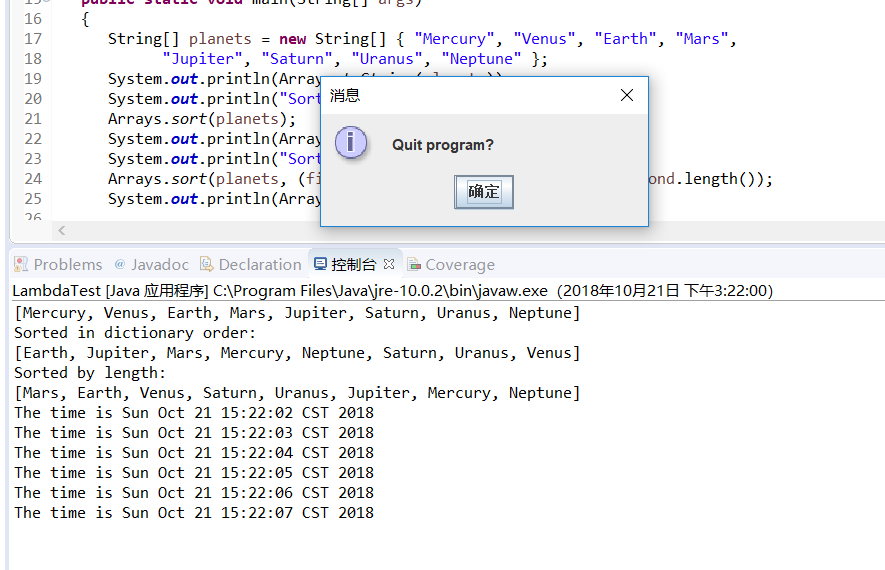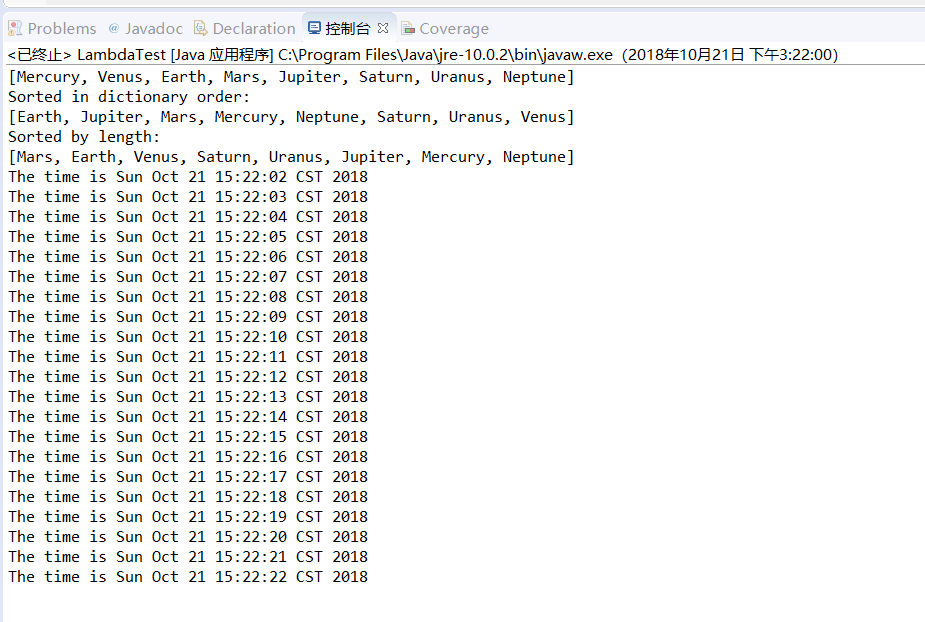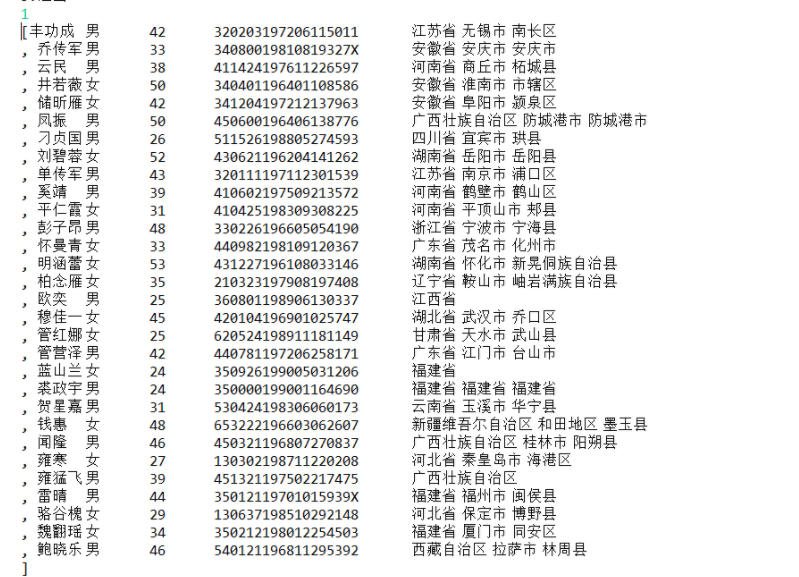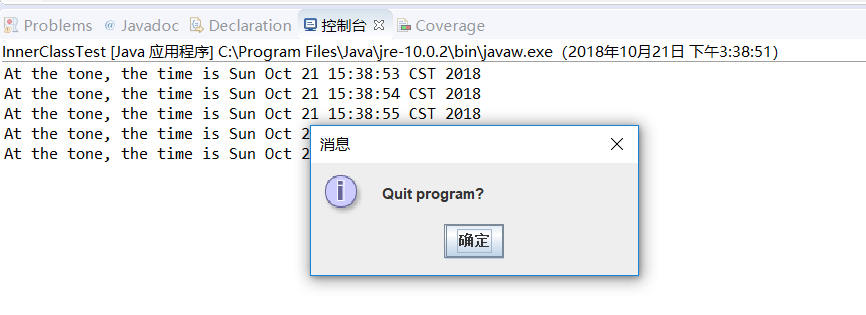201771010108 -韓臘梅-第八週學習總結
第八週實驗總結
一、知識總結
介面的總結:
1.介面本身 是一個特殊的類
2.介面的成員變數 預設是 public static final 修飾的,也就是說介面中的成員變數實際上是一個常量
3.介面中的 方法 都是抽象方法,預設修飾 public abstract
4.介面是不能夠建立物件的
5.介面是沒有構造方法
6.因為介面是提供給 類 去使用的,非抽象類去實現一個介面的時候,必須要把介面中所有的方法 都要實現。
介面的語法:
修飾符 interface 介面類{} 或者 修飾符 interface 介面類 extends 父介面1,父介面2{}
類實現的語法:
class 類名 extends 父類名 implements 介面1,介面2{類的內容}
介面方法的定義:
1.介面中的方法都是抽象方法。
2.介面中的方法,不能有任何的修飾。
3.編譯器在編譯的時候會自動為你加上public static fianl修飾。
如何使用介面的例子:
//定義介面類
interface Lock{
void unlock();
}
// 建立父類連結介面
abstract class Door implements Lock{
void openDoor(){
}
}
子類繼承父類,並繼承父類連結的介面並重寫方法
class ThelfProofDoor extends Door{
public void unlock(){
}
}
介面的作用:
1.擴充套件功能
2.定義約束規範
3.程式解耦合性
類和介面的注意點:
1.當一個 <非抽象類> 在實現 介面的時候,必須實現介面中 <所有的方法>
2.當一個抽象類,在實現介面的時候,可以實現也可以不實現 介面中的方法, 因為抽象類的子類來實現
3.一個類可以實現多個介面
4. 因為抽象類本身就不能夠被例項化,它給子類繼承用的,所以它不可以實現這個介面中的方法,而讓對應的子類來實現就可以了。(注意:如果子類也沒有實現介面中的方法,則會出錯。)
介面與介面之間的關係:
在java中類是單繼承的,一個類只有一個直接父類,介面也是可以繼承的,但是它是多繼承的,也就是一個介面可以繼承多個介面(介面的繼承是指繼承介面的方法,而且能夠多繼承的關鍵點是介面的方法是實現這個介面的類來實現的)
例如:
interface A{
void test();
}
interface B{
void test2();
}
class Test implements A,B{
public void test(){
}
public void test2(){
}
}
並且類與類之間出來繼承,介面,還有關聯。而關聯又分為依賴、聚合、組合依賴。
二、實驗內容(介面的定義與使用)
1、實驗目的與要求
(1) 掌握介面定義方法;
(2) 掌握實現介面類的定義要求;
(3) 掌握實現了介面類的使用要求;
(4) 掌握程式回撥設計模式;
(5) 掌握Comparator介面用法;
(6) 掌握物件淺層拷貝與深層拷貝方法;
(7) 掌握Lambda表示式語法;
(8) 瞭解內部類的用途及語法要求。
2、實驗內容和步驟
實驗1: 匯入第6章示例程式,測試程式並進行程式碼註釋。
測試程式1:
l 編輯、編譯、除錯執行閱讀教材214頁-215頁程式6-1、6-2,理解程式並分析程式執行結果;
l 在程式中相關程式碼處新增新知識的註釋。
l 掌握介面的實現用法;
l 掌握內建介面Compareable的用法。

package interfaces; import java.util.*; /** * This program demonstrates the use of the Comparable interface. * @version 1.30 2004-02-27 * @author Cay Horstmann */ public class EmployeeSortTest { public static void main(String[] args) { Employee[] staff = new Employee[3]; staff[0] = new Employee("Harry Hacker", 35000); staff[1] = new Employee("Carl Cracker", 75000); staff[2] = new Employee("Tony Tester", 38000); Arrays.sort(staff); // 列印所有員工物件的資訊 for (Employee e : staff) System.out.println("name=" + e.getName() + ",salary=" + e.getSalary()); } }EmployeeSortTest

package interfaces; //將類宣告為實現為某個介面,使用implements關鍵字 public class Employee implements Comparable<Employee> { private String name; private double salary; public Employee(String name, double salary) { this.name = name; this.salary = salary; } public String getName() { return name; } public double getSalary() { return salary; } public void raiseSalary(double byPercent) { double raise = salary * byPercent / 100; salary += raise; } /** * Compares employees by salary * @param other another Employee object * @return a negative value if this employee has a lower salary than * otherObject, 0 if the salaries are the same, a positive value otherwise */ public int compareTo(Employee other) { // 這裡使用了靜態Double.compare方法,且為泛型Comparable提供了一個型別引數 return Double.compare(salary, other.salary); } }Employee

package interfaces; //將類宣告為實現為某個介面,使用implements關鍵字 public class Employee implements Comparable<Employee> { private String name; private double salary; public Employee(String name, double salary) { this.name = name; this.salary = salary; } public String getName() { return name; } public double getSalary() { return salary; } public void raiseSalary(double byPercent) { double raise = salary * byPercent / 100; salary += raise; } /** * Compares employees by salary * @param other another Employee object * @return a negative value if this employee has a lower salary than * otherObject, 0 if the salaries are the same, a positive value otherwise */ public int compareTo(Employee other) { // 這裡使用了靜態Double.compare方法,且為泛型Comparable提供了一個型別引數 return Double.compare(salary, other.salary); } }Employee

測試程式2:
l 編輯、編譯、除錯以下程式,結合程式執行結果理解程式;
| interface A { double g=9.8; void show( ); } class C implements A { public void show( ) {System.out.println("g="+g);} }
class InterfaceTest { public static void main(String[ ] args) { A a=new C( ); a.show( ); System.out.println("g="+C.g); } } |
程式碼:

package g; class InterfaceTest { public static void main(String[ ] args) { A a=new C( ); a.show( ); System.out.println("g="+C.g); } }InterfaceTest

package g; interface A { double g=9.8; void show( ); }A

package g; class C implements A { public void show( ) {System.out.println("g="+g);} }C
實驗結果:

測試程式3:
l 在elipse IDE中除錯執行教材223頁6-3,結合程式執行結果理解程式;
l 26行、36行程式碼參閱224頁,詳細內容涉及教材12章。
l 在程式中相關程式碼處新增新知識的註釋。
l 掌握回撥程式設計模式;

package timer; /** @version 1.01 2015-05-12 @author Cay Horstmann */ import java.awt.*; import java.awt.event.*; import java.util.*; import javax.swing.*; import javax.swing.Timer; // to resolve conflict with java.util.Timer public class TimerTest { public static void main(String[] args) { ActionListener listener = new TimePrinter(); // 構造一個timer物件存放在變數裡,叫做listener // 每次間隔10秒 Timer t = new Timer(10000, listener); t.start(); JOptionPane.showMessageDialog(null, "Quit program?"); System.exit(0); } } class TimePrinter implements ActionListener { public void actionPerformed(ActionEvent event) { System.out.println("At the tone, the time is " + new Date()); Toolkit.getDefaultToolkit().beep(); } }timer
實驗結果:

執行結束:

測試程式4:
l 除錯執行教材229頁-231頁程式6-4、6-5,結合程式執行結果理解程式;
l 在程式中相關程式碼處新增新知識的註釋。
l 掌握物件克隆實現技術;
l 掌握淺拷貝和深拷貝的差別。

package clone; /** * This program demonstrates cloning. * @version 1.10 2002-07-01 * @author Cay Horstmann */ public class CloneTest { public static void main(String[] args) { try { Employee original = new Employee("John Q. Public", 50000); original.setHireDay(2000, 1, 1); Employee copy = original.clone(); copy.raiseSalary(10); copy.setHireDay(2002, 12, 31); System.out.println("original=" + original); System.out.println("copy=" + copy); } catch (CloneNotSupportedException e) { e.printStackTrace(); } } }Cloneable

package clone; import java.util.Date; import java.util.GregorianCalendar; public class Employee implements Cloneable { private String name; private double salary; private Date hireDay; public Employee(String name, double salary) { this.name = name; this.salary = salary; hireDay = new Date(); } public Employee clone() throws CloneNotSupportedException { // call Object.clone() Employee cloned = (Employee) super.clone(); // clone mutable fields cloned.hireDay = (Date) hireDay.clone(); return cloned; } /** * Set the hire day to a given date. * @param year the year of the hire day * @param month the month of the hire day * @param day the day of the hire day */ public void setHireDay(int year, int month, int day) { Date newHireDay = new GregorianCalendar(year, month - 1, day).getTime(); // Example of instance field mutation hireDay.setTime(newHireDay.getTime()); } public void raiseSalary(double byPercent) { double raise = salary * byPercent / 100; salary += raise; } public String toString() { return "Employee[name=" + name + ",salary=" + salary + ",hireDay=" + hireDay + "]"; } }Employee
實驗結果:

實驗2: 匯入第6章示例程式6-6,學習Lambda表示式用法。
l 除錯執行教材233頁-234頁程式6-6,結合程式執行結果理解程式;
l 在程式中相關程式碼處新增新知識的註釋。
l 將27-29行程式碼與教材223頁程式對比,將27-29行程式碼與此程式對比,體會Lambda表示式的優點。

package lambda; import java.util.*; import javax.swing.*; import javax.swing.Timer; /** * This program demonstrates the use of lambda expressions. * @version 1.0 2015-05-12 * @author Cay Horstmann */ public class LambdaTest { public static void main(String[] args) { String[] planets = new String[] { "Mercury", "Venus", "Earth", "Mars", "Jupiter", "Saturn", "Uranus", "Neptune" }; System.out.println(Arrays.toString(planets)); System.out.println("Sorted in dictionary order:"); Arrays.sort(planets); System.out.println(Arrays.toString(planets)); System.out.println("Sorted by length:"); Arrays.sort(planets, (first, second) -> first.length() - second.length()); System.out.println(Arrays.toString(planets)); Timer t = new Timer(1000, event -> System.out.println("The time is " + new Date())/*lambda表示式*/); t.start(); // keep program running until user selects "Ok" JOptionPane.showMessageDialog(null, "Quit program?"); System.exit(0); } }lambda
實驗結果:


注:以下實驗課後完成
實驗3: 程式設計練習
l 編制一個程式,將身份證號.txt 中的資訊讀入到記憶體中;
l 按姓名字典序輸出人員資訊;
l 查詢最大年齡的人員資訊;
l 查詢最小年齡人員資訊;
l 輸入你的年齡,查詢身份證號.txt中年齡與你最近人的姓名、身份證號、年齡、性別和出生地;
l 查詢人員中是否有你的同鄉。
import java.io.BufferedReader; import java.io.File; import java.io.FileInputStream; import java.io.FileNotFoundException; import java.io.IOException; import java.io.InputStreamReader; import java.util.ArrayList; import java.util.Arrays; import java.util.Collections; import java.util.Scanner; public class H{ private static ArrayList<Mest> studentlist; public static void main(String[] args) { studentlist = new ArrayList<>(); Scanner scanner = new Scanner(System.in); File file = new File("C:\\身份證號.txt"); try { FileInputStream fis = new FileInputStream(file); BufferedReader in = new BufferedReader(new InputStreamReader(fis)); String temp = null; while ((temp = in.readLine()) != null) { Scanner linescanner = new Scanner(temp); linescanner.useDelimiter(" "); String name = linescanner.next(); String number = linescanner.next(); String sex = linescanner.next(); String age = linescanner.next(); String province =linescanner.nextLine(); Mest student = new Mest(); student.setName(name); student.setnumber(number); student.setsex(sex); int a = Integer.parseInt(age); student.setage(a); student.setprovince(province); studentlist.add(student); } } catch (FileNotFoundException e) { System.out.println("學生資訊檔案找不到"); e.printStackTrace(); } catch (IOException e) { System.out.println("學生資訊檔案讀取錯誤"); e.printStackTrace(); } boolean isTrue = true; while (isTrue) { System.out.println("1:字典排序"); System.out.println("2:輸出年齡最大和年齡最小的人"); System.out.println("3:尋找老鄉"); System.out.println("4:尋找年齡相近的人"); System.out.println("5:退出"); String m = scanner.next(); switch (m) { case "1": Collections.sort(studentlist); System.out.println(studentlist.toString()); break; case "2": int max=0,min=100; int j,k1 = 0,k2=0; for(int i=1;i<studentlist.size();i++) { j=studentlist.get(i).getage(); if(j>max) { max=j; k1=i; } if(j<min) { min=j; k2=i; } } System.out.println("年齡最大:"+studentlist.get(k1)); System.out.println("年齡最小:"+studentlist.get(k2)); break; case "3": System.out.println("家庭住址:"); String find = scanner.next(); String place=find.substring(0,3); for (int i = 0; i <studentlist.size(); i++) { if(studentlist.get(i).getprovince().substring(1,4).equals(place)) System.out.println("province"+studentlist.get(i)); } break; case "4": System.out.println("年齡:"); int yourage = scanner.nextInt(); int near=agematched(yourage); int value=yourage-studentlist.get(near).getage(); System.out.println(""+studentlist.get(near)); break; case "5": isTrue = false; System.out.println("退出程式!"); break; default: System.out.println("輸入錯誤"); } } } public static int agematched(int age) { int j=0,min=53,value=0,k=0; for (int i = 0; i < studentlist.size(); i++) { value=studentlist.get(i).getage()-age; if(value<0) value=-value; if (value<min) { min=value; k=i; } } return k; } }
public class M implements Comparable<M> { private String name; private String number ; private String sex ; private int age; private String province; public String getName() { return name; } public void setName(String name) { this.name = name; } public String getnumber() { return number; } public void setnumber(String number) { this.number = number; } public String getsex() { return sex ; } public void setsex(String sex ) { this.sex =sex ; } public int getage() { return age; } public void setage(int age) { this.age= age; } public String getprovince() { return province; } public void setprovince(String province) { this.province=province ; } public int compareTo(M o) { return this.name.compareTo(o.getName()); } public String toString() { return name+"\t"+sex+"\t"+age+"\t"+number+"\t"+province+"\n"; } }
public class M implements Comparable<M> { private String name; private String number ; private String sex ; private int age; private String province; public String getName() { return name; } public void setName(String name) { this.name = name; } public String getnumber() { return number; } public void setnumber(String number) { this.number = number; } public String getsex() { return sex ; } public void setsex(String sex ) { this.sex =sex ; } public int getage() { return age; } public void setage(int age) { this.age= age; } public String getprovince() { return province; } public void setprovince(String province) { this.province=province ; } public int compareTo(M o) { return this.name.compareTo(o.getName()); } public String toString() { return name+"\t"+sex+"\t"+age+"\t"+number+"\t"+province+"\n"; } }
實驗結果:(字典排序)

實驗4:內部類語法驗證實驗
實驗程式1:
l 編輯、除錯執行教材246頁-247頁程式6-7,結合程式執行結果理解程式;
l 瞭解內部類的基本用法。

package innerClass; import java.awt.*; import java.awt.event.*; import java.util.*; import javax.swing.*; import javax.swing.Timer; /** * This program demonstrates the use of inner classes. * @version 1.11 2015-05-12 * @author Cay Horstmann */ public class InnerClassTest { public static void main(String[] args) { TalkingClock clock = new TalkingClock(1000, true); clock.start(); // keep program running until user selects "Ok" JOptionPane.showMessageDialog(null, "Quit program?"); System.exit(0); } } /** * A clock that prints the time in regular intervals. */ class TalkingClock { private int interval; private boolean beep; /** * Constructs a talking clock * @param interval the interval between messages (in milliseconds) * @param beep true if the clock should beep */ public TalkingClock(int interval, boolean beep) { this.interval = interval; this.beep = beep; } /** * Starts the clock. */ public void start() { ActionListener listener = new TimePrinter(); Timer t = new Timer(interval, listener); t.start(); } public class TimePrinter implements ActionListener { public void actionPerformed(ActionEvent event) { System.out.println("At the tone, the time is " + new Date()); if (beep) Toolkit.getDefaultToolkit().beep(); } } }innerClass
實驗結果:


實驗程式2:
l 編輯、除錯執行教材254頁程式6-8,結合程式執行結果理解程式;
l 瞭解匿名內部類的用法。

package anonymousInnerClass; import java.awt.*; import java.awt.event.*; import java.util.*; import javax.swing.*; import javax.swing.Timer; /** * This program demonstrates anonymous inner classes. * @version 1.11 2015-05-12 * @author Cay Horstmann */ public class AnonymousInnerClassTest { public static void main(String[] args) { TalkingClock clock = new TalkingClock(); clock.start(1000, true); // keep program running until user selects "Ok" JOptionPane.showMessageDialog(null, "Quit program?"); System.exit(0); } } /** * A clock that prints the time in regular intervals. */ class TalkingClock { /** * Starts the clock. * @param interval the interval between messages (in milliseconds) * @param beep true if the clock should beep */ public void start(int interval, boolean beep) { ActionListener listener = new ActionListener() { public void actionPerformed(ActionEvent event) { System.out.println("At the tone, the time is " + new Date()); if (beep) Toolkit.getDefaultToolkit().beep(); } }; Timer t = new Timer(interval, listener); t.start(); } }anonymousInnerClass
實驗結果:

實驗程式3:
l 在elipse IDE中除錯執行教材257頁-258頁程式6-9,結合程式執行結果理解程式;
l 瞭解靜態內部類的用法。

package staticInnerClass; /** * This program demonstrates the use of static inner classes. * @version 1.02 2015-05-12 * @author Cay Horstmann */ public class StaticInnerClassTest { public static void main(String[] args) { double[] d = new double[20]; for (int i = 0; i < d.length; i++) d[i] = 100 * Math.random(); ArrayAlg.Pair p = ArrayAlg.minmax(d); System.out.println("min = " + p.getFirst()); System.out.println("max = " + p.getSecond()); } } class ArrayAlg { /** * A pair of floating-point numbers */ public static class Pair { private double first; private double second; /** * Constructs a pair from two floating-point numbers * @param f the first number * @param s the second number */ public Pair(double f, double s) { first = f; second = s; } /** * Returns the first number of the pair * @return the first number */ public double getFirst() { return first; } /** * Returns the second number of the pair * @return the second number */ public double getSecond() { return second; } } /** * Computes both the minimum and the maximum of an array * @param values an array of floating-point numbers * @return a pair whose first element is the minimum and whose second element * is the maximum */ public static Pair minmax(double[] values) { double min = Double.POSITIVE_INFINITY; double max = Double.NEGATIVE_INFINITY; for (double v : values) { if (min > v) min = v; if (max < v) max = v; } return new Pair(min, max); } }staticInnerClass
實驗結果;

三、實驗總結
本次實驗主要是為了掌握介面定義方法,實現介面類的定義要求, 實現了介面類的使用要求; 掌握程式回撥設計模式,Comparator介面用法;掌握Lambda表示式語法;對於課文中的實驗例項老師都講的很清楚,理解的也比較好,但在操作實驗中,尤其是:實驗3: 程式設計練習,程式一直出不來,好多細節上還是很容易出錯,希望在理解這些知識點的基礎上可以有寫進步。

